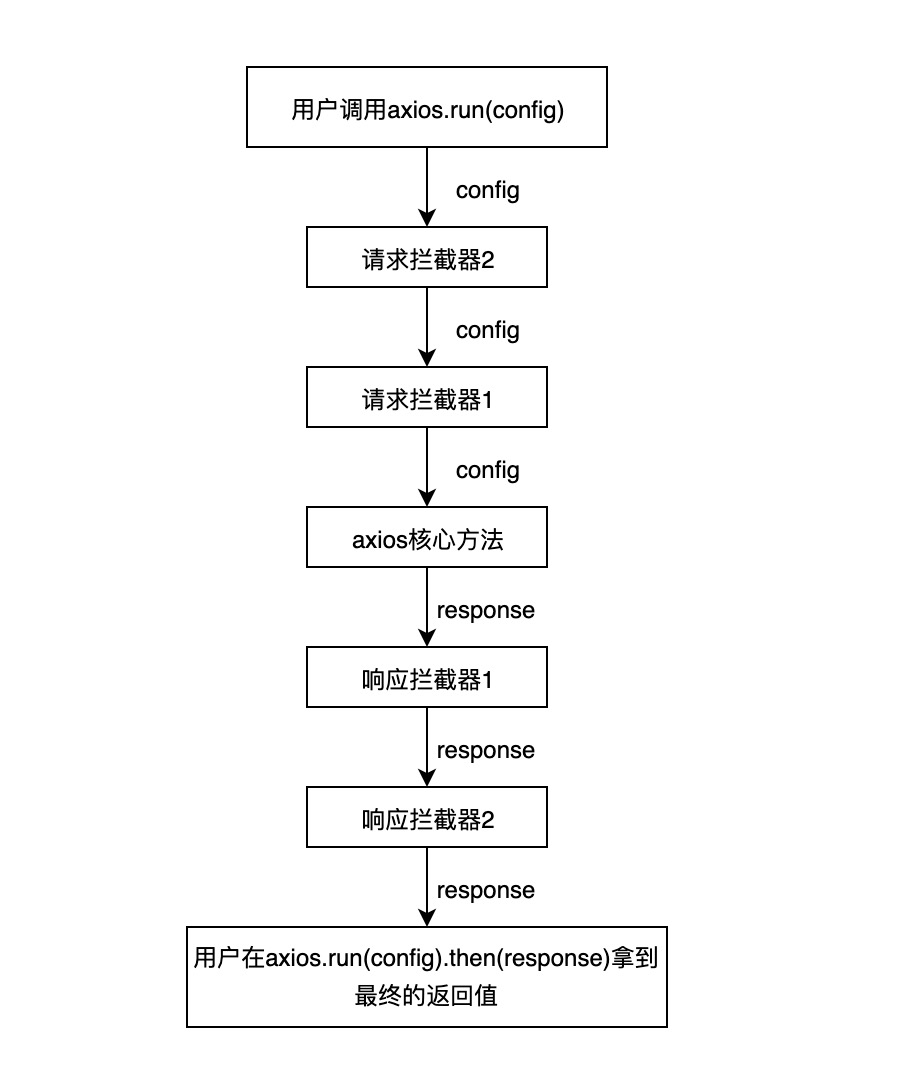前端网红框架的插件机制全梳理(axios、koa、redux、vuex)
前言
前端中的库很多,开发这些库的作者会尽可能的覆盖到大家在业务中千奇百怪的需求,但是总有无法预料到的,所以优秀的库就需要提供一种机制,让开发者可以干预插件中间的一些环节,从而完成自己的一些需求。
本文将从koa、axios、vuex和redux的实现来教你怎么编写属于自己的插件机制。
对于新手来说:
本文能让你搞明白神秘的插件和拦截器到底是什么东西。对于老手来说:
在你写的开源框架中也加入拦截器或者插件机制,让它变得更加强大吧!
axios
首先我们模拟一个简单的 axios,这里不涉及请求的逻辑,只是简单的返回一个 Promise,可以通过 config 中的 error 参数控制 Promise 的状态。
axios 的拦截器机制用流程图来表示其实就是这样的:
 流程图
流程图const axios = config => {
if (config.error) {
return Promise.reject({
error: "error in axios"
});
} else {
return Promise.resolve({
...config,
result: config.result
});
}
};
如果传入的 config 中有 error 参数,就返回一个 rejected 的 promise,反之则返回 resolved 的 promise。
先简单看一下 axios 官方提供的拦截器示例:
axios.interceptors.request.use(
function(config) {
// 在发送请求之前做些什么
return config;
},
function(error) {
// 对请求错误做些什么
return Promise.reject(error);
}
);
// 添加响应拦截器
axios.interceptors.response.use(
function(response) {
// 对响应数据做点什么
return response;
},
function(error) {
// 对响应错误做点什么
return Promise.reject(error);
}
);
可以看出,不管是 request 还是 response 的拦截器,都会接受两个函数作为参数,一个是用来处理正常流程,一个是处理失败流程,这让人想到了什么?
没错,promise.then接受的同样也是这两个参数。
axios 内部正是利用了 promise 的这个机制,把 use 传入的两个函数作为一个intercetpor,每一个intercetpor都有resolved和rejected两个方法。
// 把
axios.interceptors.response.use(func1, func2)
// 在内部存储为
{
resolved: func1,
rejected: func2
}
接下来简单实现一下,这里我们简化一下,把axios.interceptor.request.use转为axios.useRequestInterceptor来简单实现:
// 先构造一个对象 存放拦截器
axios.interceptors = {
request: [],
response: []
};
// 注册请求拦截器
axios.useRequestInterceptor = (resolved, rejected) => {
axios.interceptors.request.push({ resolved, rejected });
};
// 注册响应拦截器
axios.useResponseInterceptor = (resolved, rejected) => {
axios.interceptors.response.push({ resolved, rejected });
};
// 运行拦截器
axios.run = config => {
const chain = [
{
resolved: axios,
rejected: undefined
}
];
// 把请求拦截器往数组头部推
axios.interceptors.request.forEach(interceptor => {
chain.unshift(interceptor);
});
// 把响应拦截器往数组尾部推
axios.interceptors.response.forEach(interceptor => {
chain.push(interceptor);
});
// 把config也包装成一个promise
let promise = Promise.resolve(config);
// 暴力while循环解忧愁
// 利用promise.then的能力递归执行所有的拦截器
while (chain.length) {
const { resolved, rejected } = chain.shift();
promise = promise.then(resolved, rejected);
}
// 最后暴露给用户的就是响应拦截器处理过后的promise
return promise;
};
从axios.run这个函数看运行时的机制,首先构造一个chain作为 promise 链,并且把正常的请求也就是我们的请求参数 axios 也构造为一个拦截器的结构,接下来
- 把 request 的 interceptor 给 unshift 到
chain顶部 - 把 response 的 interceptor 给 push 到
chain尾部
以这样一段调用代码为例:
// 请求拦截器1
axios.useRequestInterceptor(resolved1, rejected1);
// 请求拦截器2
axios.useRequestInterceptor(resolved2, rejected2);
// 响应拦截器1
axios.useResponseInterceptor(resolved1, rejected1);
// 响应拦截器
axios.useResponseInterceptor(resolved2, rejected2);
这样子构造出来的 promise 链就是这样的chain结构:
[
请求拦截器2,// ↓config
请求拦截器1,// ↓config
axios请求核心方法, // ↓response
响应拦截器1, // ↓response
响应拦截器// ↓response
]
至于为什么 requestInterceptor 的顺序是反过来的,仔细看看代码就知道 XD。
有了这个chain之后,只需要一句简短的代码:
let promise = Promise.resolve(config);
while (chain.length) {
const { resolved, rejected } = chain.shift();
promise = promise.then(resolved, rejected);
}
return promise;
promise 就会把这个链从上而下的执行了。
以这样的一段测试代码为例:
axios.useRequestInterceptor(config => {
return {
...config,
extraParams1: "extraParams1"
};
});
axios.useRequestInterceptor(config => {
return {
...config,
extraParams2: "extraParams2"
};
});
axios.useResponseInterceptor(
resp => {
const {
extraParams1,
extraParams2,
result: { code, message }
} = resp;
return `${extraParams1} ${extraParams2} ${message}`;
},
error => {
console.log("error", error);
}
);
- 成功的调用
在成功的调用下输出 result1: extraParams1 extraParams2 message1
(async function() {
const result = await axios.run({
message: "message1"
});
console.log("result1: ", result);
})();
- 失败的调用
(async function() {
const result = await axios.run({
error: true
});
console.log("result3: ", result);
})();
在失败的调用下,则进入响应拦截器的 rejected 分支:
首先打印出拦截器定义的错误日志:error { error: 'error in axios' }
然后由于失败的拦截器
error => {
console.log('error', error)
},
没有返回任何东西,打印出result3: undefined
可以看出,axios 的拦截器是非常灵活的,可以在请求阶段任意的修改 config,也可以在响应阶段对 response 做各种处理,这也是因为用户对于请求数据的需求就是非常灵活的,没有必要干涉用户的自由度。
vuex
vuex 提供了一个 api 用来在 action 被调用前后插入一些逻辑:
https://vuex.vuejs.org/zh/api/#subscribeaction
store.subscribeAction({
before: (action, state) => {
console.log(`before action ${action.type}`);
},
after: (action, state) => {
console.log(`after action ${action.type}`);
}
});
其实这有点像 AOP(面向切面编程)的编程思想。
在调用store.dispatch({ type: 'add' })的时候,会在执行前后打印出日志
before action add
add
after action add
来简单实现一下:
import {
Actions,
ActionSubscribers,
ActionSubscriber,
ActionArguments
} from "./vuex.type";
class Vuex {
state = {};
action = {};
_actionSubscribers = [];
constructor({ state, action }) {
this.state = state;
this.action = action;
this._actionSubscribers = [];
}
dispatch(action) {
// action前置监听器
this._actionSubscribers.forEach(sub => sub.before(action, this.state));
const { type, payload } = action;
// 执行action
this.action[type](this.state, payload).then(() => {
// action后置监听器
this._actionSubscribers.forEach(sub => sub.after(action, this.state));
});
}
subscribeAction(subscriber) {
// 把监听者推进数组
this._actionSubscribers.push(subscriber);
}
}
const store = new Vuex({
state: {
count: 0
},
action: {
async add(state, payload) {
state.count += payload;
}
}
});
store.subscribeAction({
before: (action, state) => {
console.log(`before action ${action.type}, before count is ${state.count}`);
},
after: (action, state) => {
console.log(`after action ${action.type}, after count is ${state.count}`);
}
});
store.dispatch({
type: "add",
payload: 2
});
此时控制台会打印如下内容:
before action add, before count is 0
after action add, after count is 2
轻松实现了日志功能。
当然 Vuex 在实现插件功能的时候,选择性的将 type payload 和 state 暴露给外部,而不再提供进一步的修改能力,这也是框架内部的一种权衡,当然我们可以对 state 进行直接修改,但是不可避免的会得到 Vuex 内部的警告,因为在 Vuex 中,所有 state 的修改都应该通过 mutations 来进行,但是 Vuex 没有选择把 commit 也暴露出来,这也约束了插件的能力。
redux
想要理解 redux 中的中间件机制,需要先理解一个方法:compose
function compose(...funcs: Function[]) {
return funcs.reduce((a, b) => (...args: any) => a(b(...args)));
}
简单理解的话,就是compose(fn1, fn2, fn3) (...args) = > fn1(fn2(fn3(...args)))
它是一种高阶聚合函数,相当于把 fn3 先执行,然后把结果传给 fn2 再执行,再把结果交给 fn1 去执行。
有了这个前置知识,就可以很轻易的实现 redux 的中间件机制了。
虽然 redux 源码里写的很少,各种高阶函数各种柯里化,但是抽丝剥茧以后,redux 中间件的机制可以用一句话来解释:
把 dispatch 这个方法不断用高阶函数包装,最后返回一个强化过后的 dispatch
以 logMiddleware 为例,这个 middleware 接受原始的 redux dispatch,返回的是
const typeLogMiddleware = dispatch => {
// 返回的其实还是一个结构相同的dispatch,接受的参数也相同
// 只是把原始的dispatch包在里面了而已。
return ({ type, ...args }) => {
console.log(`type is ${type}`);
return dispatch({ type, ...args });
};
};
有了这个思路,就来实现这个 mini-redux 吧:
function compose(...funcs) {
return funcs.reduce((a, b) => (...args) => a(b(...args)));
}
function createStore(reducer, middlewares) {
let currentState;
function dispatch(action) {
currentState = reducer(currentState, action);
}
function getState() {
return currentState;
}
// 初始化一个随意的dispatch,要求外部在type匹配不到的时候返回初始状态
// 在这个dispatch后 currentState就有值了。
dispatch({ type: "INIT" });
let enhancedDispatch = dispatch;
// 如果第二个参数传入了middlewares
if (middlewares) {
// 用compose把middlewares包装成一个函数
// 让dis
enhancedDispatch = compose(...middlewares)(dispatch);
}
return {
dispatch: enhancedDispatch,
getState
};
}
接着写两个中间件
// 使用
const otherDummyMiddleware = dispatch => {
// 返回一个新的dispatch
return action => {
console.log(`type in dummy is ${type}`);
return dispatch(action);
};
};
// 这个dispatch其实是otherDummyMiddleware执行后返回otherDummyDispatch
const typeLogMiddleware = dispatch => {
// 返回一个新的dispatch
return ({ type, ...args }) => {
console.log(`type is ${type}`);
return dispatch({ type, ...args });
};
};
// 中间件从右往左执行。
const counterStore = createStore(counterReducer, [
typeLogMiddleware,
otherDummyMiddleware
]);
console.log(counterStore.getState().count);
counterStore.dispatch({ type: "add", payload: 2 });
console.log(counterStore.getState().count);
// 输出:
// 0
// type is add
// type in dummy is add
// 2
koa
koa 的洋葱模型想必各位都听说过,这种灵活的中间件机制也让 koa 变得非常强大,本文也会实现一个简单的洋葱中间件机制。参考(umi-request 的中间件机制)
 洋葱圈
洋葱圈对应这张图来看,洋葱的每一个圈就是一个中间件,它即可以掌管请求进入,也可以掌管响应返回。
它和 redux 的中间件机制有点类似,本质上都是高阶函数的嵌套,外层的中间件嵌套着内层的中间件,这种机制的好处是可以自己控制中间件的能力(外层的中间件可以影响内层的请求和响应阶段,内层的中间件只能影响外层的响应阶段)
首先我们写出Koa这个类
class Koa {
constructor() {
this.middlewares = [];
}
use(middleware) {
this.middlewares.push(middleware);
}
start({ req }) {
const composed = composeMiddlewares(this.middlewares);
const ctx = { req, res: undefined };
return composed(ctx);
}
}
这里的 use 就是简单的把中间件推入中间件队列中,那核心就是怎样去把这些中间件组合起来了,下面看composeMiddlewares方法:
function composeMiddlewares(middlewares) {
return function wrapMiddlewares(ctx) {
// 记录当前运行的middleware的下标
let index = -1;
function dispatch(i) {
// index向后移动
index = i;
// 找出数组中存放的相应的中间件
const fn = middlewares[i];
// 最后一个中间件调用next 也不会报错
if (!fn) {
return Promise.resolve();
}
return Promise.resolve(
fn(
// 继续传递ctx
ctx,
// next方法,允许进入下一个中间件。
() => dispatch(i + 1)
)
);
}
// 开始运行第一个中间件
return dispatch(0);
};
}
简单来说 dispatch(n)对应着第 n 个中间件的执行,而 dispatch(n)又拥有执行 dispatch(n + 1)的权力,
所以在真正运行的时候,中间件并不是在平级的运行,而是嵌套的高阶函数:
dispatch(0)包含着 dispatch(1),而 dispatch(1)又包含着 dispatch(2) 在这个模式下,我们很容易联想到try catch的机制,它可以 catch 住函数以及函数内部继续调用的函数的所有error。
那么我们的第一个中间件就可以做一个错误处理中间件:
// 最外层 管控全局错误
app.use(async (ctx, next) => {
try {
// 这里的next包含了第二层以及第三层的运行
await next();
} catch (error) {
console.log(`[koa error]: ${error.message}`);
}
});
在这个错误处理中间件中,我们把 next 包裹在 try catch 中运行,调用了 next 后会进入第二层的中间件:
// 第二层 日志中间件
app.use(async (ctx, next) => {
const { req } = ctx;
console.log(`req is ${JSON.stringify(req)}`);
await next();
// next过后已经能拿到第三层写进ctx的数据了
console.log(`res is ${JSON.stringify(ctx.res)}`);
});
在第二层中间件的 next 调用后,进入第三层,业务逻辑处理中间件
// 第三层 核心服务中间件
// 在真实场景中 这一层一般用来构造真正需要返回的数据 写入ctx中
app.use(async (ctx, next) => {
const { req } = ctx;
console.log(`calculating the res of ${req}...`);
const res = {
code: 200,
result: `req ${req} success`
};
// 写入ctx
ctx.res = res;
await next();
});
在这一层把 res 写入 ctx 后,函数出栈,又会回到第二层中间件的await next()后面
console.log(`req is ${JSON.stringify(req)}`);
await next();
// <- 回到这里
console.log(`res is ${JSON.stringify(ctx.res)}`);
这时候日志中间件就可以拿到ctx.res的值了。
想要测试错误处理中间件 就在最后加入这个中间件
// 用来测试全局错误中间件
// 注释掉这一个中间件 服务才能正常响应
app.use(async (ctx, next) => {
throw new Error("oops! error!");
});
最后要调用启动函数:
app.start({ req: "ssh" });
控制台打印出结果:
req is "ssh"
calculating the res of ssh...
res is {"code":200,"result":"req ssh success"}
总结
axios把用户注册的每个拦截器构造成一个 promise.then 所接受的参数,在运行时把所有的拦截器按照一个 promise 链的形式以此执行。
- 在发送到服务端之前,config 已经是请求拦截器处理过后的结果
- 服务器响应结果后,response 会经过响应拦截器,最后用户拿到的就是处理过后的结果了。
vuex的实现最为简单,就是提供了两个回调函数,vuex 内部在合适的时机去调用(我个人感觉大部分的库提供这样的机制也足够了)。redux的源码里写的最复杂最绕,它的中间件机制本质上就是用高阶函数不断的把 dispatch 包装再包装,形成套娃。本文实现的已经是精简了 n 倍以后的结果了,不过复杂的实现也是为了很多权衡和考量,Dan 对于闭包和高阶函数的运用已经炉火纯青了,只是外人去看源码有点头秃...koa的洋葱模型实现的很精妙,和 redux 有相似之处,但是在源码理解和使用上个人感觉更优于 redux 的中间件。
中间件机制其实是非框架强相关的,请求库一样可以加入 koa 的洋葱中间件机制(如 umi-request),不同的框架可能适合不同的中间件机制,这还是取决于你编写的框架想要解决什么问题,想给用户什么样的自由度。
希望看了这篇文章的你,能对于前端库中的中间件机制有进一步的了解,进而为你自己的前端库加入合适的中间件能力。
本文所写的代码都整理在这个仓库里了:
https://github.com/sl1673495/tiny-middlewares
代码是使用 ts 编写的,js 版本的代码在 js 文件夹内,各位可以按自己的需求来看。
推荐阅读
我的公众号能带来什么价值?(文末有送书规则,一定要看)
每个前端工程师都应该了解的图片知识(长文建议收藏)
为什么现在面试总是面试造火箭?
